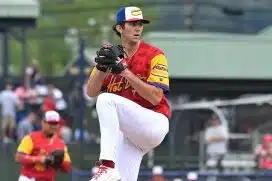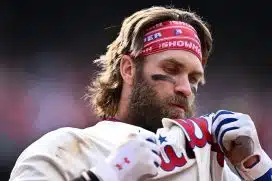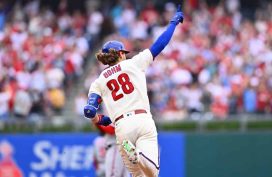By Tal Venada, Sports Talk Philly Contributor
For the Philadelphia Phillies faithful, missing the 2020 playoffs was squarely on the MLB-worst relief corps. Clearly, this is a must-fix shortcoming for the organization to end their postseason drought of nine seasons because the locals don’t want to see or hear a full 162 replay summed up in three words. And now pitching!
Measured Relief:
Costwise and talentwise, replacing the entire pen is not a realistic goal because free agents JT Realmuto and Didi Gregorius could re-up to reprise their 2020 roles. And the Phillies also need a rotation piece due to a departure. So, the front office has those openings to plug, as they compete for solid relievers.
IN OTHER WORDS:
“What we need is more people who specialize in the impossible.” – Theodore Roethke
In ‘21, games played and attendance will depend on the pandemic in April especially after losses of $100-120 million per deep-pocketed franchise. And wealthy spenders are reluctant due to 2021’s financial uncertainty over the offseason and into March, so this will affect offers and trade-based decisions.
Though some will question certain moves, be aware of the pitfalls. To illustrate, some hurlers dropped 2-5 mph off their fastball due to lacking the adrenaline they have with a rooting home crowd or jeering away spectators. And 2020’s stats could also be deceptive due to only 60 contests and interrupted winter routines.
Despite fans’ beliefs, most bullpens have only 3-5 solid arms out of eight. The others are middle relievers who appear in low-stress situations: mop-up duty, long relief, extra innings, and frames before the sixth. By comparison, all stats are not equal.
While many believe the New York Yankees have the ultimate relief corps, they finished an MLB 16th last summer with a 4.51 ERA. And Aroldis Chapman, Zack Britton and Chad Green were their top hurlers, while Adam Octavino had a down campaign. Well, so much for this: The grass in Yankee Stadium is greener.
Some readers want an entirely new pen and might want eight proven arms: AAV (average annual value) is possible but not probable. For instance, a closer ($10 million AAV), three setup men ($24 million AAV) and four solid moundsmen ($16 million AAV) will cost $50 million AAV: not doable with $64.3 million AAV.
Think of it as making selections from a price list with some stars exceeding your budget. Translation: Luxury Tax penalties have even the Bronx Bombers exceeding all three thresholds for a specific ace and cutting expenditures the following 162 to limit the financial and draft-pick consequences.
According to FanGraphs, the Phillies have an AAV payroll of $145.7 million with 2021’s $210 million CBT (competitive-balance threshold): $64.3 million AAV is available. But the coronavirus-influenced market will probably force most clubs to either be slightly under the CBT if they aren’t cost-cutting.
Phillies AAV Payroll:
|
PLAYER |
ANNUAL DOLLARS |
|
JT Realmuto |
$25 million |
|
Didi Gregorius |
$13 million |
|
Starting Pitcher |
$8 million |
|
Closer |
$7 million |
|
2 Setup Men |
$8 million ($4 million each) |
|
5 at or near the MLB minimum |
$3 million (average of $0.6 million each) |
|
TOTAL |
$64 Million of $64.3 million ($0.3 million extra) |
Open Positions:
If you would rather not wait on Realmuto ($25 million AAV), James McCann has a $10 million AAV projection for each of two seasons. Thusly, the red pinstripes would have another $15 million AAV for pitching, a middle infielder, or a left-handed bat with power.
Passing on Gregorius would free up $13 million AAV if the Phils go with second baseman Scott Kingery, shortstop Jean Segura and third sacker Alec Bohm. Remember, after Kingery had contracted COVID-19, he had aftereffects when he played. So, ‘20 may have been misleading, and he could rebound with his best summer.
In free agency, the signings have been one-year deals. The inkings were Robbie Ray at $8 million by the Toronto Blue Jays, $11 million for ex-Phillies starter Drew Smyly and $15 million for Charlie Morton by the Atlanta Braves. Now, Michael Wacha ($3 million in 2020) is drawing the most interest among starters.
Instead of Wacha or the $8 million AAV for two campaigns of Taijuan Walker, the good guys could spend $13 million AAV for three seasons of Jake Odorizzi or Masahiro Tanaka. But you must deduct $5 million AAV if you’re playing by rules and limitations, not a restriction-free world.
In order to plug most holes, Brad Hand at $7 million AAV for two summers would allow funds for other needs. But if you prefer spending for the top closer, Liam Hendriks, almost 32, has a forecast of $10 million per 162 for $30 million total. Ergo, the $3 million addition means a deduction elsewhere.
For the two setup roles, Shane Greene and lefty Jose Alvarez would run basically $4 million each for ‘21. But if you spend $7 million apiece for two years, you could chase Blake Treinen and/or Trevor May, but $4 million or $8 million would come from another hole.
The five hurlers to round out the pen include southpaw Ranger Suarez, who had an excellent 2019 but a virus-influenced 2020. Moreover, Connor Brogdon and left-hander Jojo Romero will compete for a roster spot at or near the major league minimum salary against non-roster invitees.
For reserves after deducting the $1.3 million for the bullpen, the Phillies will need an infielder and a left-side hitter for the $2 million remaining from the table-listed $3.3 million (including the excess $0.3 million). Or they can spend $4 million for Jay Bruce by taking $3 million from somewhere else.
Well, left-handed Odubel Herrera’s $6.1 million AAV for ‘21 is already in the Fightins’ $145.7 million payroll, and he would be a model citizen if he gets a second chance. Boo? But he could make himself valuable enough to interest another team.
Five Candidates to Return:
As for the keepers, five hurlers will fill out the relief corps if the Fightins ink a closer and two setup men. And they would be Hector Neris, Vince Velasquez, Suarez, Romero and Brogdon; but their assignments won’t be equal: Pitching in a critical inning isn’t the same as working the sixth frame or earlier.
Keep in mind, 2020’s non-continuous schedule followed the break in offseason continuity, the downtime between spring training and summer camp prior to the canned applause of cardboard spectators. Therefore, 2020’s statistics aren’t a total indication of the relievers below.
Phillies relief corps’ results toward 75-80 percent:
|
Name |
Good |
So-so |
Tot |
Bad |
B'up* |
Tot |
Nos. |
Pct. |
|
Neris |
13 |
2 |
15 |
9 |
0 |
9 |
15 of 24 |
62.5% |
|
HN 2019 |
50 |
3 |
53 |
12 |
2 |
13 |
53 of 68 |
77.9% |
|
Velasquez |
1 |
0 |
1 |
1 |
0 |
1 |
1 of 2 |
50% |
|
VV 2019 |
6 |
2 |
8 |
1 |
1 |
2 |
8 of 10 |
80% |
|
Suarez |
0 |
0 |
0 |
3 |
0 |
3 |
0 of 3 |
0% |
|
RS 2019 |
28 |
3 |
31 |
6 |
0 |
6 |
31 of 37 |
83.8% |
|
Romero |
7 |
1 |
8 |
3 |
1 |
4 |
8 of 12 |
66.7% |
|
Brogdon |
5 |
1 |
6 |
1 |
2 |
3 |
6 of 9 |
66.7% |
* Blowup.
The above numbers were from a running total including poor outcomes with inherited runners.
The faithful were nervous with Neris because he mostly faced the opposition’s best during the final three innings. In fact, Joe Girardi said he was his top reliever (and always healthy), while Seranthony Dominguez and David Robertson were only on the injured list. So, the skipper didn’t have better options, did he?
With a solid starter and Spencer Howard in the rotation, Velasquez could join the pen: He had nine acceptable outings out of 12 (75 percent) over two years. But he is a non-tender candidate with a final arb-eligible prediction of $4.3 million (setup-man pay). Yes, the Phillies could compete with other clubs to ink him for less.
After a strong showing in ‘19 and a possible spot on the five-man staff, Suarez missed several weeks due to the coronavirus and then couldn’t get ready in the taxi squad for the majors. Basically, he deserves an earned shot to bounce back.
Romero impressed fans and former closers alike when he dominated with six acceptable performances (five good) out of seven. However, he had only two good outings with three bad (two blowups) out of his last five. And the league probably caught up to him among other considerations.
Following a bad first impression of one good appearance and two blowups, Brogdon returned to Allentown. But soured-on-him locals missed his rebound of six performances with a 0.00 ERA and 14 punch outs over 8 ⅔ innings including one bad outing by walking in an inherited runner.
Basically, I have read many “if I were the GM” comments or implied remarks regarding the toughest job in baseball. But what if you raise your game with some real decisions the execs must make this winter, how would you do then? Me, I mostly write what their hole-plugging choices are financially.
Would you pass on Realmuto or wait him out? Would you re-sign Gregorius for three years or gamble on Kingery? Would you spend more on pitching at the expense of the offense? Well, I have four words of advice for you, my readers. Gobble up those gobblers!
NEXT:
Realmuto’s Negotiating Details for 2021







